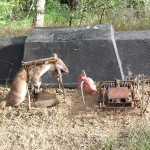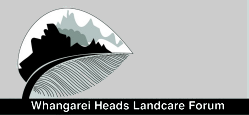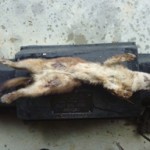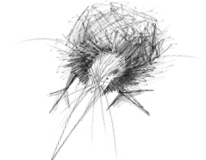Stoats – Our Biggest Threat to Kiwi Chicks
Stoats are public enemy number 1 for kiwi chicks. In untrapped areas, 90% of kiwi chicks are killed by stoats in their first six months of life. These tough, smart, killing machines have had a major impact on New Zealand’s kiwi populations.
At the Whangarei Heads we were lucky enough to have a kiwi population of around 80 adult kiwi in 2001. Without trapping, the offspring of these birds didn’t stand much of a chance and eventually we would have no kiwi here.
Below you will find links to the annual trapping reports with detailed information regarding predator trapping – now updated for the most recent year’s report.
In 2001 the local Landcare groups got together in a super-group called the Whangarei Heads Landcare Forum (WHLF). Amongst other things, the WHLF started a kiwi recovery project on private land throughout the Heads. The Department of Conservation was already predator trapping the Bream Head reserve and the WHLF set up a trapping network to compliment this.
The traps are set in tunnels to keep non-target species (like kiwi!) out, and because stoats love tunnels. We have a network of about 250 traps from Bream Head to Parua Bay and across to Kauri Mountain. The traps are baited with salted rabbit and have been effective in reducing the numbers of stoats and other predators (cats, weasels and ferrets).  Kiwi chick survival is way up now and the kiwi population has grown to around 300 kiwi in our backyard.
Kiwi chick survival is way up now and the kiwi population has grown to around 300 kiwi in our backyard.
We are lucky that we are a peninsula as this limits predator reinvasion – but stoats travel large distances and we still catch around 25 stoats each year.
Trapping Report
The WHLF have carried out predator trapping for kiwi recovery at the Whangarei Heads since 2002. This report covers the period October 2012 to September 2013 but also includes some comments relating to the 2013-14.
Trap coverage
The trapping network covers approximately 6000ha of the Whangarei Heads peninsula and has been in place since 2002, with fine tuning of trap locations and additional traps installed over time.
As of September 2013 the traps in place were:
Mustelid traps: 198 double sets of Mark 6 Fenn traps in plastic tunnels; 81 Doc 200 sets and 24 Doc 250 single sets in boxes, 10 A24 Henry traps.
Cat traps: 35 SA Cat traps; 10 live capture cages are used as required.
In addition to these WHLF traps the Department of Conservation Whangarei Area Office also operates traps at the Nook, Taurikura Ridge, South Manaia Walkway, and Mount Aubrey. The Department of Conservation and Bream Head Conservation Trust (BHCT) also have a trapping programme at the Bream Head Reserve. Trap catches from those traps are not included in tallies here.
The trapping networks of the DOC, WHLF and BHCT compliment each over and give effective coverage over the majority of the peninsula. The central ridge of Mt Manaia is an area with only limited trap coverage. The use of a controlled 1080 toxin pulse in bait stations in 2010 and planned again for 2014 on Mt Manaia helps address the low trap density there.
For the 2013-2014 season the Kiwi Coast initiative has funded traps and trapping time for an additional 72 mustelid traps in western Mt Manaia and the northern end of the WHLF area.
Lure
Salted rabbit remains the main lure used because of its attractiveness to stoats, lasting properties, ease of distribution and storage in freezers. Bait changes are 3 weekly December to March, monthly April, May, September, October and November, and 6 weekly June to August.
Chicken eggs are used over the winter months as they are more suited to the 6 weekly trap checking period used then. Only 2 stoats were caught on egg lure.
Predators trapped:
Comments on 2012/2013 programme by species.
Ferrets
No ferrets were caught in the 2012-13 season. Although only 1 ferret has be caught since 2004 the trapping network continues to include traps capable of catching ferrets (Mk 6 Fenn traps and Doc 250s) as ferrets are capable of killing sub-adult and adult kiwi. A single ferret can do significant damage to a kiwi population.
Stoats
42 stoats were caught in the 2012-13 season this is well up on our average annual catch of 23 stoats over the previous 10 years and close to our peak of 55 in the first season 11 years ago. Stoat catches by other groups in the Whangarei area were also high for the season. Although stoat catch numbers were high their catch pattern was similar to previous years. Catches peaked in January at 11 stoats.
It was a drought year but the previous drought year of 2009-10 resulted in our lowest ever stoat tally of only 17 so it is unlikely that the drought conditions lead to the high stoat numbers.
The stoat catches for the current season (2013-14) have returned to normal rates.
See section 4.0 of this report for discussion on trap shy stoats within long running trapping systems and use of secondary poisoning as a control method for these animals.
Weasels
Weasel captures were 20, similar to the average catch tally of 21 of the past 10 seasons but still down from the first season catch of 46.

Cats
Cat captures were 19 this season, close to the average of 21 of the past 10 seasons and well down from the peak of 38 for the 2004-05 season.

Rats
Recorded rat catches in the predator traps totaled 421 our highest recorded catch but this was only 18% above our average catch of 358. The seasonal catches range from a low of 304 in 2006-07 to a high of 403 in 2004-05 prior to this season’s high.
22 Norway rats were identified out of the total (approximately 5%) although many of the trappers do not distinguish between rat species on their records.
In addition to these rat catches individual projects within the WHLF project area carry out targeted rat control using appropriate toxins. The efforts of those individual groups vary from year to year and the results for those projects are not included in this report.
Possums
Again in addition to the 148 possums caught in the predator traps (mainly the SA cat traps) possum control projects have been continued by individual Landcare projects within the Whangarei Heads Landcare Forum with significant catch results. The results of those projects are not included in this report.
The improved forest health and drastically reduced road kill numbers of possums at the Whangarei Heads indicate that the possum population has been significantly reduced over the past decade.
Because of concern that no future possum control is planned by DOC in the Mt Manaia reserve the WHLF, through Manaia Landcare, have initiated a joint effort with DOC, NRC, NTB and the Kiwi coast to carry out a control pulse of 1080 toxin in the bait station network at Manaia.
Hedgehogs
This season’s hedgehog catch of 49 is well down on our previous 10 year average of 79. Hedgehog catch numbers have trended down since at high of 112 in the 2008-2009 season.
Possible trap/lure shy predators
DOC work monitoring kiwi chick survival rates at the Whangarei Kiwi Sanctuary has indicated that over time chick survival rates have dropped despite an ongoing long term trapping programme there. This is thought to be due to the generation of some trap/lure shy stoats and emphasises the importance of the attention to detail needed when setting traps including the removal of any old salted rabbit lure from the area completely.
DOC trials have shown that by using secondary poisoning it is possible to remove the trap shy stoats. We were fortunate at the Whangarei Heads that DOC carried out a 1080 possum control operation using land based bait-stations at Mt Manaia reserve in the spring of 2010. As stated above WHLF have initiated a joint effort for a controlled pulse of 1080 in bait stations for the winter of 2014 which will reduce the number of trap shy predators in the area.
Previously the use of the toxin Brodifacoum (trade name “Pest Off”) has been avoided by the Landcare groups that are part of the WHLF because of the risk of secondary poisoning of non target species, such as kiwi. Now in appropriate areas we are using a controlled pulse of Brodifacoum every 3 or 4 years to gain the benefits of secondary poisoning of trap shy stoats and cats while limiting the risk of secondary poisoning to non target species.
For the 2012-13 season a controlled pulse of 100 kg of “Pest off” possum toxin in bait stations was carried out during spring in the Taurikura Ridge area. This operation will have reduced the number of trap shy predators in the area through secondary poisoning as well as providing some possum and rat control.
Community operated traps
The majority of the trapping is carried out by a professional trapper (74% of traps covered). The other traps are serviced by a hard core of community trappers who are well skilled and persistent in their trapping efforts. Thanks must go to these trappers for their dedicated work.
Co-ordination of the community trappers by the WHLF trapper was carried out by telephone contacts and site visits to supply bait, carry out trap maintenance, collect records and audit trap setting. The details of ongoing captures and timely reminders for trap maintenance etc were also communicated through the WHLF project manager’s monthly report and emails.
Funding
In July 2011 the WHLF and the Bream Head Conservation Trust (BHCT) signed a “Community Pest Control Area Management Plan” for kiwi predator control with the Northland Regional Council. This CPCA Plan covers a five year period and it is fantastic to have the NRC’s support for this extended period. This funding gives medium term security for the work needed to maintain and increase the huge gains in kiwi recovery achieved at the Whangarei Heads. Thanks in particular to Don McKenzie (NRC Biosecurity Senior Programme Manager) and Kane McElrea (NRC Biosecurity Officer) for their support and advice.
Additional funding from the Kiwi Coast initiative has enabled an expansion of trapping in the Parua Bay, Lamb road, Campbell road areas and also an upgrade of the trapping network in McLeod Bay. Thanks to Ngaire Tyson of the NZ Landcare Trust for co-coordinating the Kiwi Coast project.
The Program’s Future
A new toxin and re-setting traps have been under development for stoat control in NZ for some time. The toxin (PAPP) for the direct poisoning of predators has been registered for use. The use of PAPP has been considered and discounted at present due to the onerous need to notify individuals within 3 km of the treatment area and the labour intensive bait setting requirements. The only commercially available re-setting stoat trap is the Henry A24. 10 of these traps have been purchased and field trialed at the Whangarei Heads and have caught no stoats to date. Until an effective long life stoat lure is developed these traps are unlikely to be effective. Another major problem with these traps is their poor mechanical reliability.
Traditional trapping remains the main tool for predator control at the Whangarei Heads. Ongoing trap maintenance and fine tuning of trap positions will continue to be carried out along with the logistical and motivational support of community trappers to maintain the trapping regime and low mustelid numbers.
The combination of an extensive trapping network and a controlled 1080/ Brodifacoum pulse should be leading to a good kiwi chick survival in our area. This is supported by a number of chicks that have survived to be in excess of 1000g in weight turning up as mates for radio transmittered adults that we monitor or being handed in dead from dog or road kill.
Good chick survival has also been shown by the increasing kiwi call counts for the previous 7 seasons– (2.4 calls/hr/station 2007 to 6.8 calls/hr/station 2013).
The success of kiwi recovery at the Whangarei Heads not only depends on an effective predator trapping programme but is also reliant on ongoing community engagement to ensure effective dog control occurs. The WHLF “Backyard kiwi” work is crucial to this community engagement and has resulted in much improved dog control by Whangarei Heads locals and in turn a huge reduction in kiwi kills by dogs.
Previous trapping reports:
WHLF Trapping Report 2010-2011
WHLF Trapping Report 2009-2010






